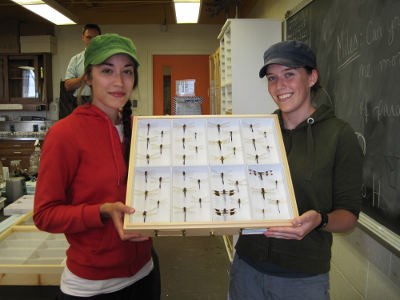Insects, whether crawling or flying, are as much an indicator of the health of the Greater Sudbury ecosystem as are fish swimming in area lakes, Joe Shorthouse, Laurentian University biologist, said.
He is coordinating an insect inventory using the campus of Laurentian University as a study site.
Shorthouse said he has been told by Laurentian University fresh water fisheries scientist John Gunn that area lakes cannot fully be restored to health until the surrounding lands are also recovering. A healthy insect population is a sign terrestrial systems are coming back, he said.
But a survey of insects, their species and populations, has never been done in Greater Sudbury.
“There is very little knowledge of what insects are out there in the damaged areas of Sudbury,” Shorthouse said.
“If we are to monitor the changes in the ecological restoration of the area we have know what is missing.”
Insects have important roles in the environment, according to Shorthouse said. Beetles break down fecal matter such as dog droppings in local parks.
“With the proper decomposer insects around, dog droppings can disappear into the bellies of insects within weeks.”
Bees pollinate plants, including backyard vegetables and fruit trees in local gardens.
Some species, such as dragonflies, dine on biting insects — horse flies, deer flies, black flies and mosquitoes — that attack people in their backyards or at their camps and cottages, he noted.
Laurentian University campus was selected because the birch forest growing there is typical of the birch transition forest common to Greater Sudbury.
The four month project, which began in May, is called a bioblitz and is the first in an urban area in Canada, Shorthouse said.
“They are a special type of field study where a group of scientists and volunteers conduct an intensive biological inventory, attempting to identify and record all species of living organisms in an area.”
In this case, insects are the subject of study.
Laurentian University biology students Courtney Rousselle and Jennifer Meehan showed off trays of mounted dragonflies and butterflies in their laboratory in the biology department.
Meehan said the amount of insect life she captured each week was surprising.
“You can't see them, but when you sweep an area with a net through the grass there are thousands of insects,” she said. “The landscape is alive with insects.”
Other means of capturing insects included pitfall traps and pan traps. The pitfall traps were made of cups in the ground, which insects would fall in to, and the pan traps were filled with a liquid that attracts insects.
There was a public session in June where the public participated in the field work as part of the bioblitz project.
One youth collected an insect that had not yet been documented by the field team, Shorthouse said. Insects are sent to experts across Canada to ensure they are properly identified.
The insects collected are being arranged in glassed trays for research and education purposes.
Shorthouse said he has no trouble engaging students when he visits local schools.
“As an entomologist, you can show insects to classes from kindergarten to grade 13,” he said. “Every kid can get turned on to insects.”
For more information, email [email protected] or phone 705-675-1151, ext. 2287.
Join Sudbury.com+
- Messages
- Post a Listing
- Your Listings
- Your Profile
- Your Subscriptions
- Your Likes
- Your Business
- Support Local News
- Payment History
Sudbury.com+ members
Already a +member?
Not a +member?
Sign up for a Sudbury.com+ account for instant access to upcoming contests, local offers, auctions and so much more.
